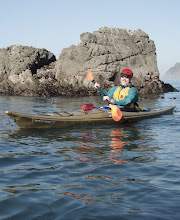In an ideal world, inexpensive cedar boards are knot and damage free and I am rich and good looking. One look at my bank balance, my face, or an inexpensive piece of cedar will tell you it is not an ideal world. And while my looks and riches are hard to change, less-than perfect cedar is not. One way to deal with damaged wood is simply to cut the damaged part out and join the remaining pieces back together. While I had to do that with a few strips on the bottom of the boat, I've avoided it wherever possible. This is especially important since I'm book-matching the strips. If I cut a chunk out of a strip, there will be a break in the pattern.
So what to do when there is ding or a gouge in a strip? Patch it, of course.
The first set of photos illustrates the process for a fairly serious gouge. The following photos show the results from repairing chip-out from some irregular grain.


The two pictures above show the original damage to the strip. This damage is from a gouge that was in the original board that I cut into strips.
 The first step is to trim/whittle the gouge as smooth as possible. On small gouges, this can be done with one or two cuts of the knife.
The first step is to trim/whittle the gouge as smooth as possible. On small gouges, this can be done with one or two cuts of the knife. If necessary, sand the gouge smooth. Yes this is the pad from a random orbital sander, and no, I didn't use the sander on this. It was a used pad with enough grit at the edge to do the sanding.
If necessary, sand the gouge smooth. Yes this is the pad from a random orbital sander, and no, I didn't use the sander on this. It was a used pad with enough grit at the edge to do the sanding. Mark a piece of similarly grained and colored wood in preparation for fitting into the smoothed gouge. For small gouges, a whittled flake of wood works fine. This being a larger gouge, it required a larger scrap of wood.
Mark a piece of similarly grained and colored wood in preparation for fitting into the smoothed gouge. For small gouges, a whittled flake of wood works fine. This being a larger gouge, it required a larger scrap of wood. Whittle and/or sand the scrap so that it fits into the smoothed gouge. Leave it oversized so it is easier to work with.
Whittle and/or sand the scrap so that it fits into the smoothed gouge. Leave it oversized so it is easier to work with.
After the glue dries, plane and/or sand the protruding scrap so that it is flush with the edge of the strip. The strip is ready to go.

 The two photos above show the process for a chip-out of irregular grain. Yes, I should have spent more time matching the grain direction. However, the color of the patch piece should darken to match the color of the strip and be virtually undetectable in a few weeks.
The two photos above show the process for a chip-out of irregular grain. Yes, I should have spent more time matching the grain direction. However, the color of the patch piece should darken to match the color of the strip and be virtually undetectable in a few weeks.There are two pieces of advice I've gotten from the Kayak Building Bulletin Board that I try to keep in mind, especially on this, my first boat: 1) It's a boat. Part of the goal is to make something beautiful, but the main goal is to make a functional watercraft. Time spent on trying to make it absolutely perfect is time that won't be spent on the water. 2) Follow the 10 foot rule. Most people will view the boat from at least 10 feet. If it looks good from 10 feet, stick with it. If not, do something about it.























